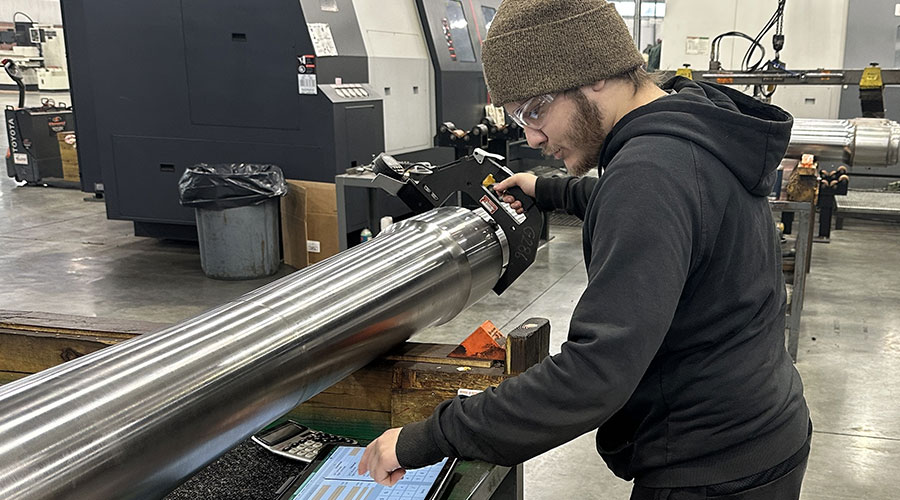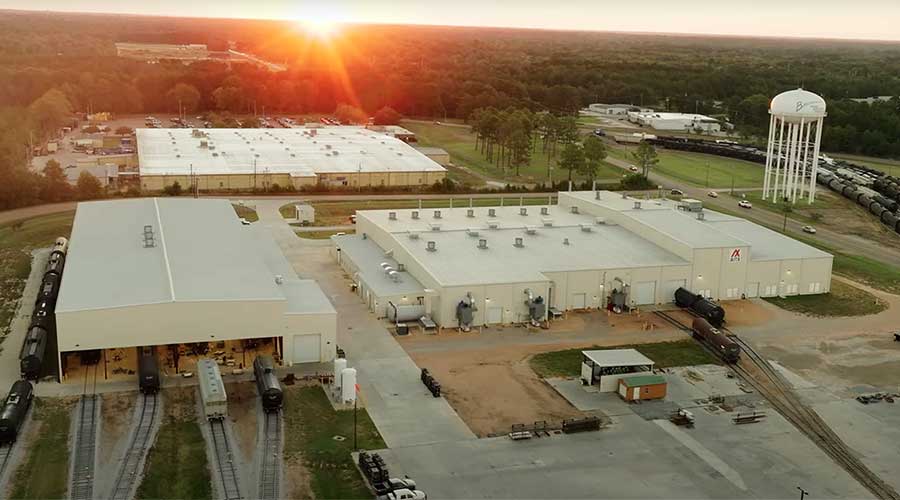Stay updated on news, articles and information for the rail industry
March 2014
Rail News: Mechanical
Liquefied natural gas could help railroads reap locomotive benefits if regulatory, technical issues are resolved
— by Jeff Stagl, Managing Editor
In the 1950s, Class Is began to convert the primary locomotive fuel source from steam to diesel, a transition that signaled a major transformation for the rail industry.
Now, Class Is are contemplating another fuel changeover that could be just as revolutionary. All the large roads are exploring the use of liquefied natural gas (LNG) to fuel line-haul locomotives instead of diesel. The benefits they could derive are promising: longer operating distances between locomotive fueling stops, reduced fuel usage and fewer greenhouse-gas emissions — perhaps even besting the U.S. Environmental Protection Agency's stringent Tier 4 air emission standard.
But there are daunting technical, operational and regulatory challenges that need to be addressed before LNG-fueled locomotives begin to dot the Class I landscape.
- Locomotive builders Electro-Motive Diesel (EMD) and GE Transportation are trying to develop or tweak engine kits that would enable existing high-horsepower units to support dual-fuel operations (via diesel or LNG) or run predominantly on LNG.
- Tender-car manufacturers are aiming to design or tailor the cars that would be positioned behind a locomotive to carry LNG.
- Class Is are attempting to gauge the fueling network necessary to accommodate the locomotives — including the cost of said infrastructure, which is estimated to be significant — and the optimal routes for deploying the newfangled motive power.
- The Federal Railroad Administration (FRA) and Transport Canada are striving to craft regulations governing LNG locomotive operations, especially tender-car standards.
The concept of using LNG to fuel locomotives isn't new. BNSF Railway Co. predecessor Burlington Northern Railroad operated some natural gas-powered locomotives in the 1980s and 1990s; BNSF tested LNG-fueled switchers in Los Angeles several years ago; and Union Pacific Railroad pursued a $15 million research program on dual-fuel locomotives in the 1990s that involved LNG.
A conversion has become attractive again because there's a greater supply of natural gas in the United States and Canada due to explosive production at a growing number of shales and basins, and the price spread between diesel and natural gas continues to favor gas.
Five Class Is now are preparing to test LNG-fueled locomotives on certain mainlines, particularly those that register high diesel-consumption rates. (Canadian Pacific and Kansas City Southern are holding discussions with locomotive and tender-car manufacturers, but have not scheduled any LNG tests or acquired any equipment.)
However, none of the large roads are planning a large-scale adoption until there is regulatory certainty and a return-on-investment is substantiated, given the potential tens or hundreds of millions of dollars each Class I might spend on a conversion. And it could take several years to sort out all the issues.
A 'Tender' Spot
For now, an Association of American Railroads (AAR) Technical Advisory Group (TAG) is trying to help the feds develop a tender-car standard. Formed in late 2012, the TAG is reviewing equipment and establishing design standards for fuel tenders, hoses, piping and other tender-locomotive interface connections, as well as addressing safety systems related to LNG-powered locomotives, interoperability and interchangeability.
TAG members include representatives from the AAR's Locomotive, Equipment Engineering and Tank Car committees, the FRA, Transport Canada, Pipeline and Hazardous Materials Safety Administration, Class Is, locomotive builders and tender-car manufacturers.
Although everyone associated with the Class Is' LNG exploration is asking when a tender-car performance standard will be established, "no one can say exactly when," says Mike Iden UP's general director of car and locomotive engineering. Therefore, LNG-powered locomotives will be applied in a "rational manner," he believes.
"This is not a fuel-nozzle alternative like renewable diesel; it's a new way of doing business," says Iden. "There's a lot of complexity."
UP, BNSF, the AAR and California Environmental Associates attempted to analyze LNG's complexities nearly seven years ago, when they jointly authored a study on natural gas-fueled locomotives. Among several recommendations, the November 2007 study determined that spark-ignited, LNG-fueled locomotives were better suited for switcher duty and impractical for line-haul use because they were inhibited by low fuel-storage capacity, range and power density.
But that recommendation no longer holds true, says Iden. Because of improved economics regarding required investments and potential fuel savings, LNG-fueled locomotives now are being evaluated for long-haul operations, or "where we consume the most fuel," he says.
"The bigger supply of natural gas has radically changed the structure of the fuels market," says Iden.
Another Look-See
To that end, UP again began to analyze LNG-fueled locomotives slightly more than a year ago. The Class I expects to begin testing a locomotive on a mainline by late 2014, says Iden, adding that the type of locomotive, route, test duration and other details haven't yet been determined. A locomotive still needs to be modified and a tender still needs to be set up, he adds.
UP currently owns two tender cars that were used as part of the 1990s research program. One car was reconditioned and used by CN for a mainline test that ended last year, says Iden. That tender is "relatively available" for UP's planned demonstration late this year, he says.
CN used UP's tender car to test a LNG-fueled train on a 300-mile portion of its mainline between Edmonton and Fort McMurray, Alberta, from September 2012 to September 2013. CN retrofitted diesel engines in two EMD SD40-2 locomotives to run on natural gas using conversion kits supplied by Energy Conversions Inc.
The 3,000-horsepower locomotives, which operated 90 percent on natural gas and 10 percent on diesel, were estimated to have reduced carbon dioxide emissions by about 30 percent and nitrogen oxide emissions by about 70 percent.
"We are the only railroad that has tested LNG on a mainline. It gave us a first step and first look into using LNG," says Gerry Weber, CN's vice president of supply, fleet and fuel. "We determined LNG is doable, [and] that we need to manage the fuel more than with diesel. Fueling infrastructure is a challenge, and we will need to take a phased approach."
Only Order On Books
CN also is the only Class I that has placed a tender-car order. In mid-2013, the Class I ordered four tenders from Westport Innovations that are slated for delivery by March's end.
The car's design places the tender in an intermodal well car, says Weber. Each tender car can support two locomotives, providing more flexibility than a big tank twice the size and avoiding the expense of assigning one tender per locomotive, he says.
Westport Innovations has been collaborating with Caterpillar Inc. since June 2012 to co-develop natural gas technology for Caterpillar products, including subsidiary Progress Rail Services' next generation of EMD locomotives. The first high-pressure, direct-injection (HPDI) locomotive will be demonstrated this year through a consortium program funded by Sustainable Technology Development Canada in partnership with CN, EMD and energy provider Gaz Métro. EMD's commercial production of HPDI locomotives is expected to begin in 2017, according to Westport.
CN plans to test the "high-pressure solution" — a kit that will enable a locomotive to be operated by LNG more than 90 percent of the time — in September or October, says Weber. Meanwhile, a test is expected to start in the second quarter on a "low-pressure solution," a kit that will allow a unit to operate on both LNG and diesel. A locomotive with a low-pressure kit will be able to travel to its next station or home facility running on diesel, if necessary.
CN currently is developing its test plan, which will require approval from Transport Canada. The agency so far has only approved the railroad's initial trial, says Weber.
"We're not ready to say we're ready to go with LNG," he says. "We still need regulatory approval in the U.S. No railroad has obtained an approved test plan yet."
That includes BNSF. The railroad has submitted a test plan to the FRA and needs a letter of concurrence from the federal agency before it can begin testing LNG-fueled locomotives, says BNSF Director of Operations Support Mike Swaney.
The Class I began to analyze the locomotives in earnest in October 2011 and has built a business case to move forward with LNG, says Mark Schulze, BNSF's vice president of safety, training and operations support. For one, a conversion would enable the railroad to remain competitive with trucking companies, some of which are converting trucks to operate on natural gas, he says.
BNSF currently is focusing on three things that need to be developed prior to conversion: engine technology with GE and EMD; tender-car technology; and a fueling network, including fueling facilities, says Schulze.
The Class I has refurbished two tender cars that were used by the Burlington Northern in the 1980s and 1990s. Two EMD locomotives underwent stationary testing with one of the tenders at a test center in Topeka, Kan., and the tender now is heading to the Transportation Technology Center Inc. in Pueblo, Colo., for design testing, says Schulze. The other tender car is being tested with two GE locomotives at the manufacturer's Erie, Pa., plant.
When ready to do so, BNSF plans to deploy LNG-fueled locomotives on corridors that have high diesel-burn rates, says Schulze.
Exploration Phase
CSX Corp. has a similar goal. And like BNSF, the railroad still is trying to iron out issues prior to any mainline tests or adoptions. CSX currently is working out technical and regulatory details with GE, tender-car vendors, fuel suppliers and the feds, says Louis Renjel, CSX's vice president of strategic infrastructure.
CSX began to explore LNG about a year ago. In November 2013, the Class I announced it partnered with GE to pilot LNG-powered locomotives.
CSX expects to test GE's NextFuel™ natural-gas retrofit kit that's designed to provide Evolution Series locomotives with dual-fuel capabilities, either operating up to 80 percent on LNG or 100 percent on diesel. The kit can reduce emissions and potentially cut fuel costs by 50 percent without compromising performance, according to GE. CSX and GE also plan to develop LNG kits for other locomotive classes.
The railroad currently is developing its test and safety plan, which might be completed in 2014's first half, says Renjel. The plan then would be submitted to the FRA for concurrence. CSX might begin to pilot LNG-fueled locomotives by year's end, depending on FRA approval, says Renjel.
The Class I is taking its time to develop the plan and will continue to work on it "until we're comfortable we got it right," he says, adding that the railroad is trying to better understand the complications of conversion and FRA rules of operation.
Class Is are working with the FRA to determine the safety implications of LNG to the fullest extent, says Renjel.
"LNG has been around for 50 years and has a good safety record in the marine and other industries," he says. "But we need to understand what's different in the rail environment."
What is clear are the potential benefits CSX can derive from LNG. In addition to generating fuel and emission savings, the natural gas could triple a train's operating range, says Renjel.
LNG and CNG
Norfolk Southern Railway also is examining LNG for many of the same reasons. The Class I currently has no plans to purchase locomotives with LNG kits, but is contemplating whether to equip its next order of new locomotives with natural gas piping as a provision for LNG, says Don Graab, NS' vice president of mechanical.
For now, the railroad is constructing a compressed natural gas (CNG)-powered locomotive at its Juniata locomotive facility in Pennsylvania. The EMD GP38-2 unit's engine is being modified to burn only CNG using a kit supplied by Energy Conversions, says Graab.
"We are using this project as a means to evaluate the feasibility of natural gas as a fuel in switching operations where the environmental impact may be a large consideration in conversion," he says.
Although it's clear there are substantial costs associated with a LNG conversion, the benefits Class Is can derive from a changeover are hard to ignore. Saving a significant amount of fuel and reducing a high amount of carbon emissions each year will help justify a conversion, says Renjel.
"This is a real opportunity to reduce our environmental footprint," he says. "We also can help develop the gas as a domestic fuel source."
Keywords
Browse articles on liquefied natural gas locomotives BNSF CN Canadian Pacific CSX Kansas City Southern Norfolk Southern Union Pacific Federal railroad Administration Transport Canada Transportation Technology Center Inc. Association of American Railroads EMD GE Transportation Westport InnovationsContact Progressive Railroading editorial staff.


 2025 MOW Spending Report: Passenger-rail programs
2025 MOW Spending Report: Passenger-rail programs
 Gardner steps down as Amtrak CEO
Gardner steps down as Amtrak CEO
 Guest comment: Oliver Wyman’s David Hunt
Guest comment: Oliver Wyman’s David Hunt
 Women of Influence in Rail eBook
Women of Influence in Rail eBook
 railPrime
railPrime








